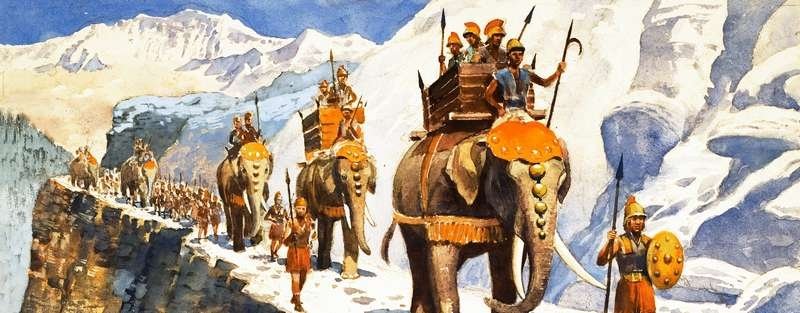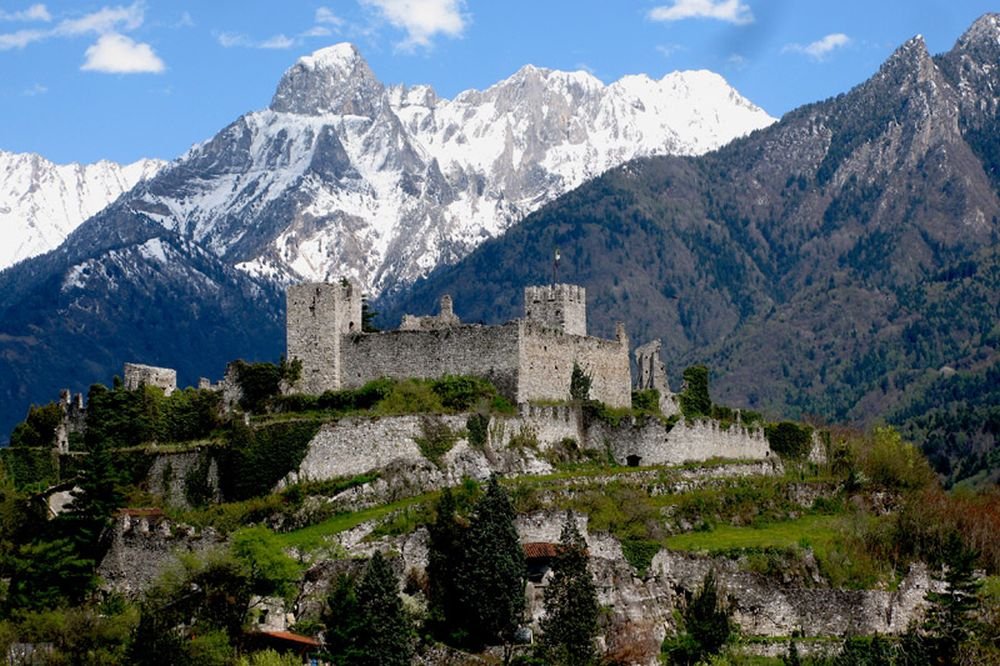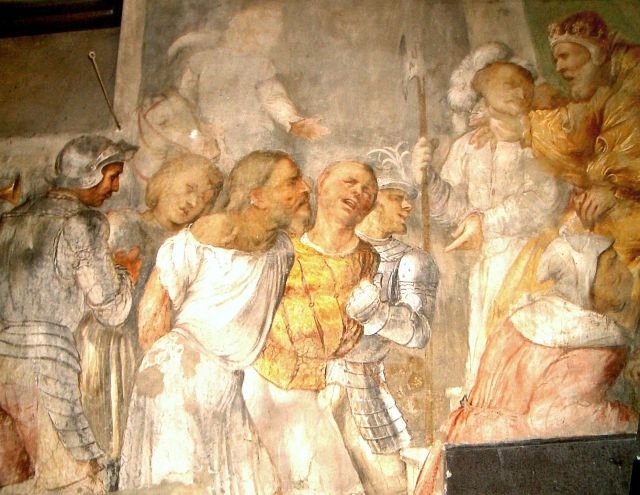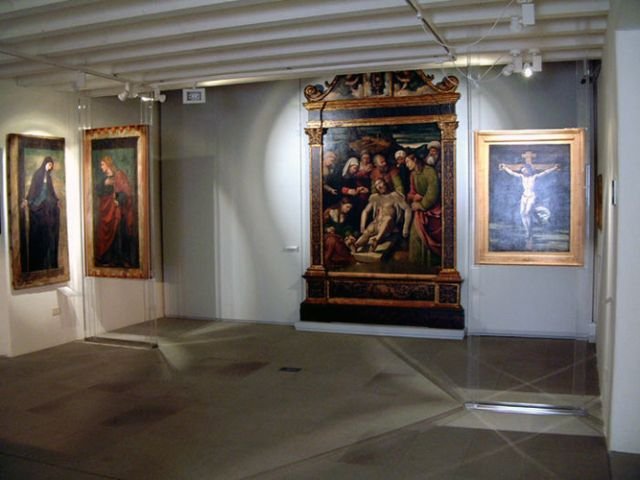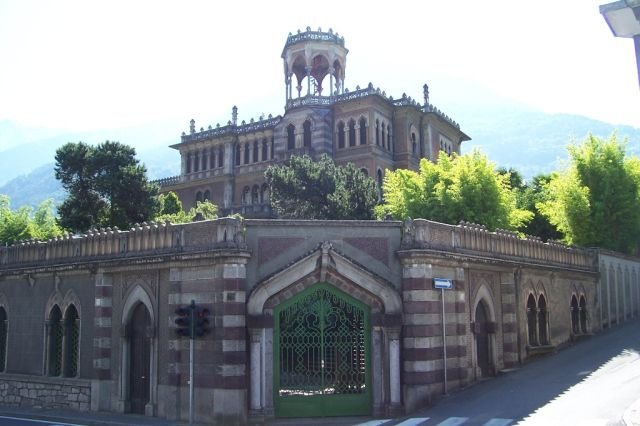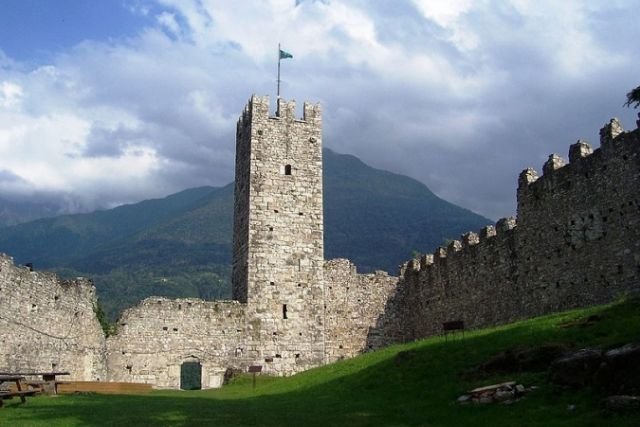'Midsommar' (2019)
I no longer do full on movie reviews, because I'm too much of a perfectionist, and I make a lot of notes, and it ends up taking way too long. In a nutshell, a group of American college students, through a Swedish exchange student, sign up to attend a rural pagan encampment in Sweden with the plan on writing a paper on their experience; their college thesis I recall. Runes were featured prominently, so I'm thinking that this may be an Asatru version of 'The Wicker Man' perhaps. Actually, the pagan tradition was "Old Norse religion," not Asatru. So I"m assuming that this would be maybe a Scandinavian equivalent to German Hexerei. So from my understanding, something of a mix of the older Proto-European tradition with elements of Asatru... "Scandinavian witchcraft"....maybe.
The protagonist Dani is a young American woman, although played by a British actress, who starts off the film in a fragile state, losing her sister and parents in a murder-suicide committed by her sister. Aside from the understandable affect this has on her, her character comes off as somewhat annoying early in the film, with a lot of abandonment and other issues. At least that was my reaction. However, as the film progresses, and she endures more hardship, her character really grows on you! She becomes likable as a vulnerable character, and with good reason for trepidation. The encampment is a farm located amid hills and some low mountains with mostly heavy brush surrounding it, in a region called Hälsingland. Living there is the old Hårga clan who work the farm, and are clearly very dedicated to their tradition. They never step our of character. As time goes on, it becomes more and more clear that they have some bizarre, barbaric, and murderous intentions. Cannibalism and necrophilia are strongly suggested as occurring, but confirmed.
This film is almost like a combination between 'The Wicker Man' (1973) and 'The Witch' (2015). The ending is much like 'The Witch' in that it doesn't completely followup with the ending. Despite the Hårga clan's dedication, they come off as cold and calculating. This film didn't do any favors for the folk pagan cause by the way. But strictly as a film in the horror film genre, it was good; starting off slowly, and becoming more and more gripping as it progressed. The sub-genre of this film is called "folk horror," horror based on real folklore. The May Day Festival was portrayed, and I don't know if that festival is present in Asatru or not. I believe it is, but under the blot name Walpurgisnacht. Despite the name, the film technically was not about Midsummer. The name "Midsommar"--pronounced "mid-so-MAR"--is apparently Midsummer in Swedish. This film was a Swedish and American collaboration, although the main character Dani was played by British actress Florence Pugh, and also several others. Not surprisingly, the clever artists at DeviantArt and other sites have created some cool artwork.
Midsommar
Folk horror
Old Norse religion
Examples of Midsommar art on DeviantArt (better to actually search that site)
Examples of Midsommar art on Pinterest (better to actualy search that site)
************
The Tradition Behind Midsommar (video)
"A mythology is the comment of one particular age or civilization on the mysteries of human existence and the human mind, their model for social behavior, and their attempt to define in stories their perception of the inner realities."
-- Hilda Ellis Davidson, 'Gods and Myths of Northern Europe
************
MIDSOMMAR (2019) Story + Ending Explained
Midsommar's "Happy" Ending, Explained
*************************
~ RIP ~
1940- 2023
Thank you!
Aspartame - A Biochemical Warfare Agent by Dr. Betty Martini (video)
*************************
'The Wicker Man' - 50 Years!
1973 - 2023
'The Wicker Man' was released in the UK on December 6, 1973. Some call it a horror film, some call it a drama, while others consider it a musical. The director was Robin Hardy, and he was a dedicated Christian, yet I think many pagans feel like this was at least something of an inspiration; not because of the sacrifice, but just the mysteries of it, the style, the symbolism, and the music! I'm sure he didn't intend on that. At some point he said that he wanted to make three films with this subject. In 2011, he made 'The Wicker Tree'. It wasn't a very good movie, despite the great name and promotional movie poster. He passed away in 2016, and never did make number three.
The Wicker Man (1973) 50th Anniversary tour (2022)
*************************
Masonic bee and beehive symbol, Venus, and our deep past
"The beehive is found in Masonry as a reminder that in diligence and labor for a common good true happiness and prosperity are found. The bee is a symbol of wisdom, for as this tiny insect collects pollen from the flowers, so men may extract wisdom from the experiences of daily life."
"The bee is sacred to the goddess Venus and, according to mystics, it is one of several forms of life which came to the Earth from the planet Venus millions of years ago. the fact that bees are ruled by queens is one reason why this insect is considered a sacred feminine symbol."
-- Manly P. Hall, 'The Secret Teachings of all Ages'
Venus, Earth, Mars, and our lost history
Sometime in the distant past, the occult evidence shows that at least the Earth, Mars, and Venus were in different positions than they are today. Saturn, currently a dwarf star, was our second star.. an "outer sun." It emitted its dimmer rays upon us, which had a slight purple hue to it, from the opposite side from the Sun from these three planets. The Earth never experienced complete darkness then. I don't know the exact time period or the exact sequence of events, but some tens of millions of years ago, an astonishing shakeup of our solar system took place. One or more incoming planets literally collided in some cases. The asteroid belt was formed from one such collision. All of this was a complete game changer. Prior to that, Venus, Earth, and Mars were all habitable, and humans existed on all three worlds. Mars was able to thrive due to the dimmer rays of Saturn. The shakeup moved Venus much closer to the Sun, ending life there. At another point, there was a massive war on Mars, fought with nuclear and energy weapons, destroying the atmosphere and ending life there. Some of the Martian humans there somehow made it to the Earth.
At some point, several incredible civilizations arose, but a major world war and Earth changes drove us back to the stone age. After those catastrophes, humans devolved, even mixing their DNA with lower hominids. Huge brutish human-like beings with double rows of teeth, who had been subdued by the earlier civilizations, were then free to roam and cause much havoc around the world. Somehow they eventually were killed off, although some were still around some centuries ago. There were other strange types of human-like beings, some very small and slight, others very short and pudgy, some with horns, etc. Every human today has at least some DNA from those lower hominids. Hollywood, with it's deep Kabbalistic and Masonic roots, has portrayed the old multi-planet human civilizations in many films; the most noteworthy being the 'Star Wars' series. It wasn't in a galaxy far, far away... it was here. The hobbit fantasy animations and films, starting in the '70s, portrayed an element of the Earth that existed in between these disasters. It's highly likely that there were visitors from elsewhere, whom interacted with humans in their heyday and even long after that.
I would encourage people to look into Manly P. Hall or the Sumerian creation myth for more clues. Basically, everything that Manly P. Hall wrote and said is true. Just because some astounding knowledge dealing with our history, reincarnation, astrology, sacred geometry, etc. was horded, doesn't make the wealthy elites in these occult circles inherently elite.They merely inherited or joined that situation. Nobody can seem to explain why when seemingly more-or-less ordinary people became massively wealthy, they almost immediately start "acting elite" and stating "elite things" that are in total congruence with the established "global elites." They live in a world and with a mindset that's so different from the average person that they couldn't bring themselves to believe it if they tried. They're into some dark things that I can't mention. What I can't figure out is why or how they believe that they're going to dodge Karma? The idea that many of them have is that by purposely releasing well-disguised clues and getting people to voluntarily sign on with them, that this is a way to avoid the consequences to their soul.
*************************
Enya - Orinoco Flow (Official 4K Music Video)
enyatv
1.12M subscribers
41M views - October 26, 2009
con't....
************
Enya - Shepherd Moons [full album]
"Her Voice has the capacity to move your soul from the deep inside..."
-- Noël Occitan
*************************
Scandinavians not indigenous to Scandinavia?
According to Norwegian Norse mythology and folk tradition author Maria Kvilhaug, Scandinavians cannot be indigenous to Scandinavia because they're not an oppressed people, and that ONLY oppressed people in the world can be indigenous to a land. Here she makes a living off of Norse myth and spiritual tradition, apparently is of Norse background, and yet she still engages in this type of "racial self-masochism."
When I was a very young boy, if I acted up, my mom would in a sense.. threaten me with "the wooden spoon!" She never used it, but she sounded like she might use it, so I listened and did what she told me. The same with my father. His theoretical weapon of choice was "the leather belt!" He never used it, but she sounded like he might use it, so I listened and did what he told me to do.
However, beyond that, I've never really listened to anything that anyone has ever told me! I did what they told me because they had the authority. I rather.. take it under advisement. I always knew that most people were trying to con me. I certainly don't listen to government officials, policemen, teachers or anyone else who takes money. I did what they told me if I had to, because they had the authority, and could punish. I can remember teachers of various ideologies who threatened students who weren't in agreement with their opinions.
*************************
My mom's very longtime vintage vase
Family friends of my mother's back in Hurley gave her this vase, and she had it for probably a good sixty years! It's a very distinct old Czech style, often orange, with that certain shape of rim, with a black snake wrapped around it like a serpent of wisdom. It was very similar to the one on the left here, except my mother's was a little taller and thinner with a longer snake... more similar to this one.
Here are a few examples of other colors and designs. It was there in her dining room buffet display for so many years, but I never really looked closely at the snake. The one on the left is $125. Someone else inherited her vase, so eventually I'm going to purchase one, or maybe a couple of them. One for the display case, and one to put on a table top. To me, it could symbolize her wisdom. This vase could have it's roots in mythology and folklore.
Loetz Czechoslovakian Art Glass Tango Vase
*************************
Similar to the vase above is the world egg., which is present in many different mythologies throughout the ancient Indo-European world. I'm sure there is a slew of YouTube videos on this, but everything can't be a video here.
The world egg, cosmic egg or mundane egg is a mythological motif found in the cosmogonies of many cultures that is present in Proto-Indo-European culture and other cultures and civilizations. Typically, the world egg is a beginning of some sort, and the universe or some primordial being comes into existence by "hatching" from the egg, sometimes lain on the primordial waters of the Earth.
Eggs symbolize the unification of two complementary principles (represented by the egg white and the yolk) from which life or existence, in its most fundamental philosophical sense, emerges.
*************************
How did dinosaurs deal with snow? (Quora)
************
Matthew Haynes:
Paleontology student at Montana State University, and life-long enthusiastAuthor has 7.5K answers and 10.3M answer views2y
Short answer: by being warm-blooded. Some may have migrated to warmer areas during winter, but even those dinosaurs probably still saw snow.
Polar dinosaurs probably had thick fat and thicker feathers than those that lived in tropical climes as well.
*************************
Lynyrd Skynyrd - Simple Man (Audio)
Lynyrd Skynyrd
1.01M subscribers
1,756,063 views - December 16, 2022
Official Audio for Simple Man performed by Lynyrd Skynyrd
Follow Lynyrd Skynyrd:
Facebook: https://facebook.com/LynyrdSkynyrd
Instagram: https://instagram.com/skynyrd
Twitter: https://twitter.com/skynyrd
Website: https://lynyrdskynyrd.com
#LynyrdSkynyrd #SimpleMan
http://vevo.ly/wKdJnV
************
"Forget your lust for the rich man's gold, all that you need is in your soul"
Wise words.
-- John
"I sang this song to my son constantly when he was a baby through his toddler years. He is now 36 & this is, & always will be "our song". Whenever it comes on we dance to it while I sing it to him & we both cry. Thank you so much for this & all the memories that go with it. 💖💖💖💖💖💖💖"
-- brenda okuda
************
I saw Lynard Skynard a couple of times many years ago, and they felt ancient then. There's still touring, and will be in the area here in Mountain View in August. Amazing.
Lynyrd Skynyrd - Simple Man - Live At The Florida Theatre / 2015 (Official Video)
*************************
“All tyrannies rule through fraud and force, but once the fraud is exposed, they must rely exclusively on force.”
-- George Orwell, '1984'
*************************
'Letter arrives more than 100 years after being posted'
Christian Edwards - CNN - February 16, 2023
London CNN
A letter has finally been delivered to its destination – more than a century after it was written.
Sent in February 1916, the correspondence arrived at its intended address in Hamlet Road, south London, much to the bewilderment of the current occupants.
“We noticed that the year on it was ’16. So we thought it was 2016,” Finlay Glen told CNN Thursday. “Then we noticed that the stamp was a King rather than a Queen, so we felt that it couldn’t have been 2016.”
Glen told CNN that the letter arrived at the property a couple of years ago, but he has only recently taken it to the local historical society, so they can research it further.
The envelope has a 1 pence stamp bearing the head of King George V. The letter was sent in the middle of World War I – more than a decade before Queen Elizabeth II was born.
con't....
************
'Crystal Palace letter arrives more than 100 years late' (BBC)
Letter arrives more than 100 years late (video)
*************************
Las Vegas at night - "the island on land"
I find the idea, and reality, fascinating that a city can stand at the edge of a wilderness. Obviously Las Vegas is a very good example of that, looking like an island of lights at night, amid the beautiful blackness of the surrounding desert and mountains. There are other aerial views of Vegas at night, showing all the lights, "the strip," but I'm speaking about the wonderful abyss. The abyss is a mystery; "what is out there?" In my former home, from the mountain slope, we could see downtown San Francisco and downtown Oakland in the far distance. All those lights, all that activity, and we were the ones in the darkness.
I once wrote a piece once on this blog about "the mystery of the mountain." When we see an unspoiled mountain, day or night, there's a mystery to it. "What animals, people, or activity is up there?" I remember when I used to look out my bedroom window at night, and into the pitch blackness of what I came to call "the canyon. The canyon itself was out of sight, but up the street was a little wooded area that led to a view of the canyon, so I was looking out towards the direction of the canyon... which at the end of the relatively steep street had a deep drop off. I will always remember the coyote howls.
I miss that a lot. Here in Sonoma, there exists a similar dynamic of that type of landscape. However, it's mostly farmland. I do see dear a lot. I hear coyotes once in awhile. There are some mountains nearby, which aren't as accessible. It's more like farmland and wineries; still dark and beautiful at night surrounding the city. I still miss home, and the life we had there. The old phrase "There's no place like home" is very true. I can think of two people who moved to NYC to be with someone, and when it didn't work out, they were so glad to be back, and one of them actually used that phrase with emphasis.
Of course, Sonoma is only 65 miles away, but it's a long 65 miles, as there are one lane roads in which you cannot simply put-put along as you must know, then even the freeway is stressful. Getting back to the original idea, I just personally find a great spiritual meaning to the wild oasis so close to the city, whether it's the bright lights of Las Vegas or San Francisco, or the dim lights of Sonoma. One evening about seven o'clock, I tried to take Highway 12 north towards Santa Rosa for a couple of stores that I looked up, and to my surprise there was 20 miles of darkness! There were some wineries, but they were all dark outside of a few dim lights in just a few places. Speaking of surprise, I see out my window here, snow on a nearby mountain. At first I thought it was a cloud.
*************************
Video Links
Little known facts about My Bodyguard - YouTube
Tyler Dinsmoor: Arrested for Speech? - YouTube
The Giant Rabbit - YouTube Drone Captures What No One Was Supposed to See - YouTube
NEAR DEATH CAPTURED by GoPro and camera pt.122 [FailForceOne] - YouTube
Deer Decomposition - Timelapse (4K) - YouTube
He found Giants then the Government Found Him | What really happened to Andrew Dawson? - YouTube
I Work Fixing Cell Towers. This Is Why I Quit. - YouTube
*************************
Elvis Presley - Can't Help Falling In Love (Official Audio)
Elvis Presley
366,329,751 views - April 23, 2013
con't....
*************************
"Open Your Mind"
*************************
"Free Your Mind"
*************************
"Be a reflection of what you'd like to see in others. If you want love, give love. If you want honesty, give honesty. If you want respect, give respect. You get in return, what you give."
-- Author unknown
************
I still prefer "Be the change you want to see in the world."
*************************
LYNX — Merciless Predator! Lynx vs wolf, beaver, deer, squirrel, hare, goat!
Get to know Animals
48.2K subscribers
3,006,812 views - May 22, 2022 #lynx
The lynx family is one of the most beautiful representatives of the cat tribe. Lynxes are incredibly dexterous predators and natural-born hunters. These wild cats can catch an expertly agile squirrel or a fast hare, as well as take down larger prey. For example, a young deer or mountain goat, whose weight can reach up to 100 kilograms. Lynxes belong to the class of predatory mammals and represent the only genus consisting of four varieties.
Subscribe: https://bit.ly/3lqQDaX
Instagram: https://www.instagram.com/animalworldclub/
*************************
Michael the Archangel
-- Artist unknown
*************************
Bobcat Takes Fox by Surprise - Beware - Content is Alarming
FoxyQ Retreat
176,113 views - December 25, 2021
SPRING MOUNTAINS
This Bobcat has been stalking FoxyQ Retreat for two days. The Owner even tried to shoo it off, but it kept returning. Unfortunately, it took a little fox by surprise. We are not sure how the little fox ended up but you can hear it put up quite a fight. Listeners are warned that the content of this video can be very alarming. It is the way of the wild. Before anyone wishes to comment about the dog's dish being out there- stop. It has been removed. Besides, FoxyQ Retreat is a certified wildlife refuge - supplying food, water, and a place to raise young for 3 or more animals. The foxes have had these. perks for the last 20 years.
************
"It's crazy how fast that bobcat struck. Wow! Foxes are notoriously fast, but that bobcat was like LIGHTNING. That's amazing."
-- Cody King
*************************
La Vieille Ferme
This is a brand of French rosé wine which I tired today. It's available at all of the main sources locally. It is produced by Château de Beaucastel Winery, located in the Rhône wine region of the South of France, and owned by Famille Perrin.
************
From the label
FRANCE AT ITS BEST
Since 1967, La Vieille Ferme has been producing authentic and delicious wines vintage after vintage, and has been acknowledged as one of the very best value wines in the world. The vines selected are grown high on the slopes, which gives this wine unique freshness and elegance. Pale pink in color, with soft undertones. Fresh and very aromatic nose, this wine has a delicate bouquet with notes of red fruit, flowers, and citrus fruit. Nice balance between sweetness and acidity in the mouth. The finish shows fresh fruit, and great length.
************
Rhône wine region
The first cultivated vines in the region were probably planted around 600 BC.
*************************
South of France
*************************
'Las Penas del Infierno'
-- Artist unknown (18th century)
A Spanish or Portuguese painter I would think. It's curious that the person didn't put their name to it.
The Laughing Heresiiarch - "Shadow Gallary"
*************************
'Our Lady of Sorrows'
-- Pedro Américo (1883)
.
































